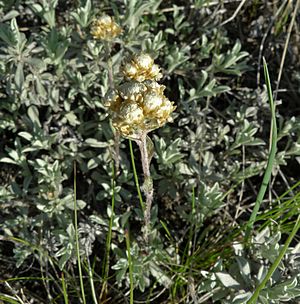Umber pussytoes facts for kids
Quick facts for kids Umber pussytoes |
|
|---|---|
 |
|
| Antennaria umbrinella on Badger Mountain, Douglas County Washington | |
| Scientific classification | |
| Genus: |
Antennaria
|
| Species: |
umbrinella
|
| Synonyms | |
|
|
The Antennaria umbrinella is a small flowering plant. It is often called umber pussytoes or brown pussytoes. This plant belongs to the daisy family. You can find it growing in North America.
This plant is native to parts of Canada and the United States. In Canada, it grows in Saskatchewan, Alberta, and British Columbia. In the U.S., it lives in western states. These include Colorado, Arizona (specifically Coconino County), and California (like Tulare County). It can grow in many different places. These range from low-lying sagebrush steppe to high subalpine meadows.
What is Antennaria Umbrinella?
This plant is a perennial herb. This means it lives for more than two years. It grows straight stems up to about 16 centimeters tall. That's roughly the length of a standard pencil. The plant grows from a woody base. It also has spreading stolons, which are like runners that help it spread.
Leaves and Flowers
The base of the plant has woolly leaves. Each leaf is about one to two centimeters long. They are shaped like a spear (lance-shaped) or a spoon. The plant produces several flower heads. These flower heads are grouped together in an inflorescence. The flower heads have fuzzy parts called phyllaries. These can be whitish to brown.
Plant Reproduction
Antennaria umbrinella is a dioecious plant. This means that male and female flowers grow on separate plants. One plant will have only male flowers, and another plant will have only female flowers. After flowering, the plant produces a fruit called an achene. This fruit has a hard body about 2 millimeters long. It also has a long, hairy pappus up to 5 millimeters long. This pappus helps the seeds float away in the wind.

